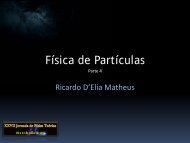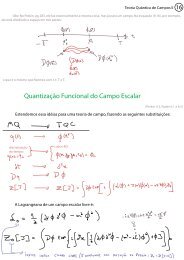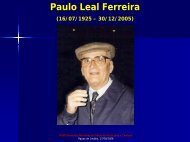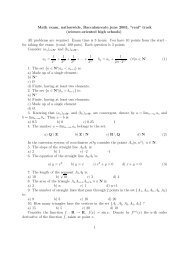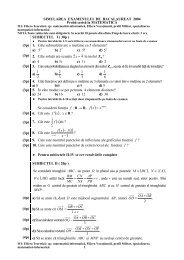P12 Tornow
P12 Tornow
P12 Tornow
Create successful ePaper yourself
Turn your PDF publications into a flip-book with our unique Google optimized e-Paper software.
Recent Few-Body Activities<br />
at TUNL and HIγS<br />
Werner <strong>Tornow</strong><br />
Duke University & Triangle Universities Nuclear Laboratory
Content<br />
A. TUNL: Polarized Neutrons<br />
1. n-p A y<br />
(θ) at E n<br />
=12 MeV<br />
2. n-d A y<br />
(θ) between E n<br />
=19 and 22.5 MeV<br />
3. n- 3 He A y<br />
(θ) between E n<br />
=2.26 and 5.54 MeV<br />
B. HIγS: Linearly Polarized Gamma-rays<br />
1. γ-d breakup photon analyzing power Σ L<br />
(θ) from 2.4 to 10 MeV<br />
2. γ- 3 He three-body breakup photon analyzing power Σ L<br />
(θ) at 15 and 12.8 MeV
Nijm PWA<br />
n-p
2<br />
R. Machleidt: πNN coupling constant g / π<br />
π<br />
4<br />
≥14.0<br />
to correctly reproduce<br />
the quadrupole moment Q of the deuteron [0.276(2) fm 2 ].<br />
Nijmegen:<br />
VPI:<br />
2<br />
2<br />
g / π 0 =13.47+-0.11 / π<br />
π<br />
4<br />
g =13.54+-0.05<br />
π 4<br />
2<br />
π / 4<br />
2<br />
g / π ≈13.3 π<br />
4<br />
π 0<br />
g ≈ 13.9<br />
g<br />
2<br />
π<br />
/ 4π<br />
≥14.0<br />
creates problems for the 3 P 0<br />
NN phase shifts (too large!) at low<br />
energies.<br />
2<br />
Assume charge splitting of πNN: /4π<br />
13. 6<br />
3<br />
P 0<br />
and Q are o.k.<br />
2<br />
g and g π<br />
+ − / 4π<br />
= 14. 4<br />
π<br />
0 =
Nijm PWA<br />
CD Bonn<br />
2<br />
2<br />
g / 4π g / 4π<br />
π /<br />
0<br />
π +−<br />
13.6 / 13.6<br />
13.6 / 14.0<br />
13.6 / 14.4<br />
2<br />
All low-energy n-p A Y<br />
(θ) data require g π<br />
+ − / 4π<br />
≥14.<br />
0
n-d<br />
Witala<br />
n-d<br />
n-d
.… Fit<br />
AV18 Witala<br />
A y<br />
θ c.m.
AV18 Witala<br />
…. Fit
TUNL data<br />
Pisa calc.<br />
p- 3 He p- 3 He
TUNL data<br />
Pisa calc.<br />
p- 3 He p- 3 He
NN Interactions in 3N and 4N Systems<br />
d<br />
d<br />
3N:<br />
p +<br />
n<br />
p<br />
1 pn + 1pp<br />
n +<br />
n<br />
p<br />
1 pn + 1 nn<br />
3<br />
He<br />
3<br />
He<br />
p +<br />
p<br />
p<br />
n<br />
1 pn + 2 pp n +<br />
p<br />
p<br />
n<br />
2 pn + 1 nn<br />
4N:<br />
3<br />
H<br />
3<br />
H<br />
n +<br />
n<br />
n<br />
p<br />
1 pn + 2 nn p +<br />
n<br />
n<br />
p<br />
2 pn + 1 pp
Fonseca<br />
…. Hale RM<br />
A y<br />
θ c.m.<br />
180
HIγS (High-Intensity Gammaray<br />
Source) at Duke/TUNL<br />
early Mono-energetic γ-rays<br />
unable Energies<br />
nergy resolution selected by collimator size<br />
inearly and Circularly Polarized γ-rays<br />
igh Beam Intensities
Upgraded Facility<br />
(3a) Building extension<br />
+ booster radiation shielding<br />
(2) 1.2-GeV Booster Injector<br />
(3b) LTB Transfer Line<br />
(3c) BTR Transfer Line<br />
(1) RF System with HOM Damping<br />
(3e) Radiation shielding<br />
over SR east arc<br />
3(d) Modifications to SR NSS
pgrade Schedule<br />
Commissioning of Booster July-August 2006<br />
Commissioning of Booster and Ring with OK-4—September-November<br />
Nuclear Physics Program begins-December, 2006<br />
Dec. 06 May 07 Linear Pol.- Below 65 MeV, >2x10 8 γ/s<br />
Sept. 07 Circ. Pol. Up to 110 MeV, >10 8 γ/s<br />
These are TOTAL intensities. Beam on target is:<br />
TOTAL x 1.5 x % resolution (ex. 5% res. at 100 MeV: 7.5 x 10 6 γ/s)<br />
Expect to have energies up to 160 MeV by Spring 09
Few-Body Physics @ ΗΙγS<br />
esolve long standing cross section<br />
problems.<br />
erform Precision tests of few-body theory<br />
including EFTs and 3-body force models<br />
using polarized beams and targets.<br />
easure fundamental properties such as the<br />
electric polarizabilities for 3 He and 4 He via
Two-Body System<br />
• Gamma-Deuteron Breakup at Low Energies
Detector Geometry<br />
: 3 He scintillator<br />
: neutron detector<br />
o<br />
θ = 90<br />
(lab)<br />
2<br />
1<br />
ε (θ )<br />
: Asymmetry<br />
N<br />
H<br />
− NV<br />
( θ ) = = p Σ ( θ )<br />
N + N<br />
ε<br />
γ L<br />
H<br />
p : γ-ray linear polarization<br />
y<br />
Σ<br />
L<br />
( ) θ<br />
V<br />
: Analyzing power<br />
3<br />
4
W. <strong>Tornow</strong>, C. Howell, V. Litvinenko, J. Kelley, et al.
The cross section and the linear analyzing power
Blowfish Detector Array<br />
Norum/Weller
The Gerasimov-Drell-Hearn (GDH) Sum Rule for Deuteron<br />
σ P/A<br />
(E) are the total cross sections for the absorption of circularly polarized<br />
photons on a target with spin Parallel/Antiparallel to the spin of the photon;<br />
κ = anomalous magnetic moment (of the deuteron).<br />
κ d<br />
= -0.143 μ m<br />
I GDH Predicted = 0.65 μb
THE GDH INTEGRAND FOR THE DEUTERON NEAR<br />
PHOTODISINTEGRATION THRESHOLD<br />
Contributions are expected from s-waves and p-waves (notation 2S+1 L J<br />
)<br />
M1 terms: 1 S 0<br />
and 3 S 1<br />
E1 terms: 1 P 1<br />
, 3 P 0<br />
, 3 P 1<br />
, and 3 P 2<br />
Expect the “spin-flip” E1 term 1 P 1<br />
~ 0.<br />
Then σ P<br />
- σ A<br />
= π/2k 2 { - 1 S 02<br />
–3/2 3 S 12<br />
- 3 P 02<br />
–3/2 3 P 12<br />
+ 5/2 3 P 22<br />
}<br />
Expect 3 P 0<br />
~ 3 P 1<br />
~ 3 P 2<br />
, and 3 S 1<br />
~ 0.<br />
So that σ P<br />
- σ A<br />
= π/2k 2 { - 1 S 02<br />
}<br />
Also, with 3 S 1<br />
~ 0 we have:<br />
σ(M1) = π/6k 2 { 1 S<br />
2<br />
0<br />
}<br />
Which gives the result:<br />
σ P<br />
- σ A<br />
= -3 σ(M1)
<strong>Tornow</strong>’s Group<br />
Norum/Weller’s Group
Three-Body Photodisintegration<br />
of 3 He<br />
• Reaction: γ + 3 He p+ p + n<br />
Q<br />
= −7.72<br />
MeV<br />
• E γ =15 MeV<br />
• <strong>Tornow</strong>’s Group
Detector Geometry<br />
: 3 He scintillator<br />
: neutron detector<br />
o<br />
θ = 90<br />
(lab)<br />
2<br />
1<br />
ε (θ )<br />
: Asymmetry<br />
N<br />
H<br />
− NV<br />
( θ ) = = p Σ ( θ )<br />
N + N<br />
ε<br />
γ L<br />
H<br />
p : γ-ray linear polarization<br />
y<br />
Σ<br />
L<br />
( ) θ<br />
V<br />
: Analyzing power<br />
3<br />
4
Deltuva et al.<br />
γ+ 3 He n+p+p
Photon Analyzing Power for<br />
3<br />
He(γ,pp)n
Time-of-Flight vs. ΣE p Spectra<br />
γ<br />
n<br />
γ<br />
n
Time-of-Flight Spectra
Photon Analyzing Power for<br />
3<br />
He(γ,pp)n<br />
• For neutrons in the energy range 1.23 to<br />
4.80 MeV, σ-weighted average of the<br />
photon analyzing power:<br />
– Theoretical prediction: Σ L (θ n =90°) = 0.949<br />
– Experimental result: Σ L (θ n =90°) = 0.95 ± 0.01
Three-Body Photodisintegration<br />
of 3 He<br />
• Target: 3 He-Xe gas scintillator<br />
– 47 atm 3 He, 3 atm Xe<br />
• Not enough stopping power for highenergy<br />
protons: they don’t deposit all of<br />
their energy: Edge effects:<br />
Scintillator housing<br />
γ-ray beam
Three-Body Photodisintegration<br />
of 3 He<br />
• Reaction: γ + 3 He p+ p + n<br />
Q<br />
= −7.72<br />
MeV<br />
• E γ =12.8 MeV<br />
• Weller’s Group
The upgraded BLOWFISH array and a 6.5 cm gas cell<br />
containing 2500 psi of 3 He was used to measure the<br />
3<br />
He(γ,n)pp reaction with 12.8 MeV linearly polarized γ<br />
rays.
Two-Body Photodisintegration<br />
of 3 He<br />
• Reaction: γ + 3 He p + d<br />
– Q = -5.49 MeV<br />
• Observable: Total cross section<br />
– Measured at E γ = 8.0, 9.0, 9.5, 10.0, 10.5,<br />
11.0, 11.5, 12.0, 12.5, 13.0, 14.0, 15.0, and<br />
16.0 MeV (13 energies)<br />
– Previously measured using a variety of<br />
techniques (bremsstrahlung photons, virtual<br />
photons from e- 3 He scattering, pd capture via<br />
detailed balance); results in disagreement
Cross Section for 3 He(γ,p)d
Cross Section for 3 He(γ,p)d<br />
Deltuva et al.<br />
with Coulomb<br />
Naito et al.
Three- and Two-Body Signal<br />
Distinction
Two-Body Photodisintegration<br />
of 3 He<br />
• Target: 3 He-Xe gas scintillator<br />
– 34 atm 3 He, 14 atm Xe<br />
• Increased Xe content to increase stopping<br />
power for protons:<br />
– Edge effects:<br />
Scintillator housing<br />
γ-ray beam
Setup for Flux Determination
γ-ray Production at HIγS<br />
W<br />
N<br />
S<br />
E<br />
Electron beam for FEL<br />
LINAC<br />
Optical Klystron<br />
γ-rays<br />
Collimato<br />
Electron beam for<br />
Compton scattering<br />
Optical beam reflected from<br />
downstream cavity mirror<br />
wo modes of operation:<br />
o electron loss (E γ < 20 MeV)<br />
lectron loss (E γ > 20 MeV)




